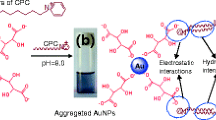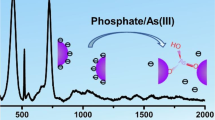Abstract
We have found that low concentrations of the polycationic disinfectant poly(hexamethylene guanidine) hydrochloride (PHMG) induce the aggregation of citrate-stabilized silver nanoparticles (AgNPs) in aqueous solution. Based on this finding, we have worked out a method to the determination of PHMG. The protocol includes the steps of (a) centrifuging the water sample, (b) addition of an aliquot of the colloidal solution of the AgNPs, and (c) measurement of the intensity of scattered light. The method is surprisingly selective in that comparable concentrations of surfactants, humic acids and protein do not interfere. Besides, an up to 50 mM concentration NaCl, and up to 5 mM of Mg(II) or Ca(II) are tolerated. Other cationic polyelectrolytes, polyethyleneimine and poly(dimethyldiallyammonium chloride), also cause aggregation of AgNPs but to a lesser extent. The determination of PHMG was performed in spiked samples (run-off, tap and swimming pool waters) with detection limits of 2·10−8, 4·10−7, and 6·10−6 M (by monomer unit), respectively. The linear ranges are wider and the detection limits are lower than those of known spectrophotometric methods. It is necessary, however, to correct the calibration plot for background scattering by the sample and to establish a calibration plot for each kind of water sample. Notwithstanding this, the approach is attractive because it is sensitive, rapid, and simple.

The polycationic disinfectant poly(hexamethylene guanidine) hydrochloride (PHMG) induces the aggregation of citrate-stabilized silver nanoparticles (AgNPs) in aqueous solution. Based on this finding, a method for the determination of ppb concentrations of PHMG by Rayleigh scattering method has been developed.







Similar content being viewed by others
References
Masadome T (2001) Flow injection spectrophotometric determination of anionic polyelectrolytes using the cationic dyes. Anal Lett 34:2711–2719. doi:10.1081/AL-100108417
Wang E (2000) Optical membrane films for polycation detection. U.S. Pat. No 6,156,274
Wang L, Buchanan S, Meyerhoff МE (2008) Rapid detection of high charge density polyanion contaminants in biomedical heparin preparations using potentiometric polyanion sensors. Anal Chem 80:9845–9847. doi:10.1021/ac801879t
Kozel SV, Skosyrskaya EK, Beklemishev MK (2008) Kinetic methods for determining water-soluble polymers. J Anal Chem 63:693–699. doi:10.1134/S1061934808070162
Determination of Long Alkyl Chain Quaternary Ammonium Compounds in Environmental Matrices by High Performance Liquid Chromatography (1996): HSMO, London
Majam S, Thompson PA (2006) Polyelectrolyte determination in drinking water. Water SA 32:705–707
Spriestersbach K-H, Frank R, Pasch H (2008) Separation of non-UV-absorbing synthetic polyelectrolytes by CE with contactless conductivity detection. Electrophoresis 29:4407–4411. doi:10.1002/elps.200800248
Gadzekpo VPY, Xiao KP, Aoki H et al (1999) Voltammetric detection of the polycation protamine by the use of electrodes modified with self-assembled monolayers of thioctic acid. Anal Chem 71:5109–5115. doi:10.1021/ac990580m
Ding SN, Chen JF, Xia J, Wang YH, Cosnier S (2013) Voltammetric detection of heparin based on anion exchange at electropolymeric film of pyrrole-alkylammonium cationic surfactant and MWCNTs composite. Electrochem Commun 34:339–343. doi:10.1016/j.elecom.2013.07.036
Alvarez-Roa ER, Prieto NE, Martin CR (1984) Luminescence titrations of polyelectrolytes. Anal Chem 56:1939–1944. doi:10.1021/ac00275a041
Masadome T (2003) Determination of cationic polyelectrolytes using a photometric titration with crystal violet as a color indicator. Talanta 59:659–666. doi:10.1016/S0039-9140(02)00581-7
Oulé MK, Quinn K, Dickman M, Bernier AM, Rondeau S, De Moissac D, Boisvert A, Diop L (2012) Akwaton, polyhexamethylene-guanidine hydrochloride-based sporicidal disinfectant: a novel tool to fight bacterial spores and nosocomial infections. J Med Microbiol 61:1421–1427. doi:10.1099/jmm0047514-0
Antonik LM, Barkova NP, Khabibulina AG, Lopyrev VA (2009) Synthesis and antiseptic and antidote activity of polyhexamethyleneguanidine hydroxyethylidenediphosphonate salt. Pharm Chem J 43:84–86
Maximum allowable concentrations of chemicals in the environment. Handbook. Ed. Krotov YuA, Karelin AO, Loit AO (2000) Mir i Semya, St-Petersburg (in Russian)
Efimov KM, Danilina NO, Ovcharenko EO, Dergacheva TV (2004) Method for quantitative determination of the concentration of polyhexamethyleneguanidine hydrochloride in water. Russ. Pat. No 2252413. http://www.findpatent.ru/patent/225/2252413.html. Accessed 10 July 2014
Chmilenko TS, Galimbievsky EA, Chmilenko FA (2010) Formation of bromophenol red ion associates and their interaction with polyhexamethyleneguanidine in aqueous solutions. Methods Objects Chem Anal 5:19–28. http://www.moca.net.ua/10/pdf/010510-19-28.pdf. Accessed 10 July 2014
Slepchenko GB, Moiseeva ES, Khazanov VA (2008) Method for quantitative determination of Anavidin by stripping voltammetry. Russ. Pat. No 2381501. http://www.freepatent.ru/patents/2381501. Accessed 10 July 2014
Apyari VV, Dmitrienko SG, Zolotov YuA (2011) A method for determining polyhexamethyleneguanidine hydrochloride. Russ. Pat. No 2460998 http://www.freepatent.ru/patents/2460998. Accessed 10 July 2014
Kato H, Suzuki M, Fujita K, Horie M, Endoh S, Yoshida Y, Iwahashi H, Takahashi K, Nakamura A, Kinugasa S (2009) Reliable size determination of nanoparticles using dynamic light scattering method for in vitro toxicology assessment. Toxicol in Vitro 23:927–934. doi:10.1016/j.tiv.2009.04.006
Liu X, Huo Q (2009) A washing-free and amplification-free one-step homogeneous assay for protein detection using gold nanoparticle probes and dynamic light scattering. J Immunol Methods 349:38–44. doi:10.1016/j.jim.2009.07.015
Zhang Y, Fei W-W, Jia N-Q (2012) A facile method for the detection of DNA by using GNPs probes coupled with dynamic light scattering. Nanoscale Res Lett 7:564–568, http://www.nanoscalereslett.com/content/7/1/564
Kalluri JR, Arbneshi T, Khan SA, Neely A, Candice P, Varisli B, Washington M, McAfee S, Robinson B, Banerjee S, Singh AK, Senapati D, Ray PC (2009) Use of gold nanoparticles in a simple colorimetric and ultrasensitive dynamic light scattering assay: selective detection of arsenic in groundwater. Angew Chem Int Ed Engl 48:9668–9671. doi:10.1002/anie.200903958
Kong L, Liu ZF, Liu SP (2014) Resonance Rayleigh scattering method for direct determination of polyacrylamide in water samples using basic phenothiazine dyes. J Anal Chem 69:149–156. doi:10.1134/S1061934814020063
Ma CQ, Li KA, Tong SY (1997) Enhancement of Rayleigh light scattering of acid chrome blue K by proteins and protein assay by the scattering technique. Analyst 122:361–364
Vidal E, Palomeque ME, Lista AG, Fernández BS (2003) Band Flow injection analysis: Rayleigh light scattering technique for total protein determination. Anal Bioanal Chem 376:38–41. doi:10.1007/s00216-003-1877-2
Zhong H, Li N, Zhao F, Li K (2004) Determination of proteins with Alizarin Red S by Rayleigh light scattering technique. Talanta 62:37–42. doi:10.1016/S0039-9140(03)00406-5
Li Y, Dong L, Wang W, Hu Z, Chen X (2006) Flow injection analysis—Rayleigh light scattering detection for online determination of protein in human serum sample. Analyt Biochem 354:64–69. doi:10.1016/j.ab.2006.02.005
Huang CZ, Li KA, Tong SY (1997) Determination of nanograms of nucleic acids by their enhancement effect on the resonance light scattering of the cobalt(II)/4-[(5-chloro-2-pyridyl)azo]-1,3-diaminobenzene complex. Anal Chem 69:514–520
Zhang Y, Fei W-W, Jia N-Q (2012) A facile method for the detection of DNA by using AuNPs probes coupled with dynamic light scattering. Nanoscale Res Lett 7:564–568. http://www.nanoscalereslett.com/content/7/1/564. Accessed 10 July 2014
Liao QG, Li YF, Huang CZ (2007) A light scattering and fluorescence emission coupled ratiometry using the interaction of functional CdS quantum dots with aminoglycoside antibiotics as a model system. Talanta 71:567–572. doi:10.1016/j.talanta.2006.04.035
Liu Z, Liu S, Wang L, Peng J, He Y (2009) Resonance Rayleigh scattering and resonance non-linear scattering method for the determination of aminoglycoside antibiotics with water solubility CdS quantum dots as probe. Spectrochim Acta A 74:36–41. doi:10.1016/j.saa.2009.04.026
Jana NR, Gearheart L, Murphy CJ (2001) Wet chemical synthesis of silver nanorods and nanowires of controllable aspect ratio. Chem Commun 7:617–618. doi:10.1039/B100521I
Parazak DP, Burkhardt CW, McCarthy KJ (1987) Determination of low levels of cationic polyelectrolytes in water. Anal Chem 59:1444–1445. doi:10.1021/ac00137a015
Garrido C, Aguayo T, Clavijo E, Gómez-Jeria JS, Campos-Vallette MM (2013) The effect of the pH on the interaction of L-arginine with colloidal silver nanoparticles. A Raman and SERS study. J Raman Spectrosc 44:1105–1110. doi:10.1002/jrs.4331
Beklemishev MK, Stoyan TA, Dolmanova IF (1997) Sorption–catalytic determination of manganese directly on a paper-based chelating sorbent. Analyst 122:1161–1165. doi:10.1039/A702595E
Rudnev AV, Dzherayan TG (2006) Determination of polyhexamethyleneguanidine by capillary electrophoresis. J Anal Chem 61:1002–1005. doi:10.1134/S1061934806100091
Chmilenko FA, Korobova IV, Mikulenko OV (2008) Potentiometric sensors for the determination of water-soluble polyelectrolytes. J Anal Chem 63:590–595. doi:10.1134/S1061934808060130
Methods for the determination of the residual concentration of disinfectant “DeFlok” in water (by PHMG-HCl). http://deflok.ru/wp-content/uploads/2013/05/DeFlok_Prilozhenie.pdf. Accessed 8 Oct 2014
Acknowledgments
Authors thank Russian Science Foundation for the financial support (grant No 14-23-00012), Agilent Technologies Russia for the technical support, Dr. Elena Lasareva, Anna Romanchuk and Alexander Sidorov for DLS and zeta potential measurements, and Prof. Irina V. Perminova for donating the humic acids.
Author information
Authors and Affiliations
Corresponding author
Electronic supplementary material
Below is the link to the electronic supplementary material.
ESM 1
(DOC 5.17 mb)
Rights and permissions
About this article
Cite this article
Artemyeva, A.A., Samarina, T.O., Sharov, A.V. et al. Highly sensitive determination of poly(hexamethylene guanidine) by Rayleigh scattering using aggregation of silver nanoparticles. Microchim Acta 182, 965–973 (2015). https://doi.org/10.1007/s00604-014-1411-6
Received:
Accepted:
Published:
Issue Date:
DOI: https://doi.org/10.1007/s00604-014-1411-6




